 General Information
General InformationGreen Roofs
Rainwater Harvesting
Ponds and Wetlands
Energy-Efficient Building
Design Principles
Weatherseals
Building Gaskets
Glazing Gaskets
Timber Glazing
Air-Vapor Films
Attic Access
Ventilation
Sealants
Shim Screws
Wood Repair
Documents
Waterproofing

OCCUPANT-SENSING VENTILATION
Energy-efficient buildings need mechanical ventilation to maintain indoor air quality and prevent premature building deterioration. Our occupant-sensing ventilation system offers the efficiency of central heat-recovery ventilation with the responsiveness of distributed exhaust fans, all at a very affordable cost.
LIMITATIONS OF TRADITIONAL VENTILATION SYSTEMS: A ventilation system can operate all the time (continuous ventilation) or only when desired (intermittent ventilation). It can draw air from one room (single-point ventilation) or from multiple rooms (multi-point ventilation). It can exhaust air from the building and let fresh air leak in (exhaust-only ventilation) or it can transfer energy between the exhaust air duct and a fresh air duct (energy-recovery ventilation).
Designing a ventilation system has always involved significant compromises. Continuous ventilation doesn’t respond to changes in occupant behavior, while intermittent ventilation doesn’t control background air pollutants. Single-point ventilation requires multiple holes through the building envelope, while multi-point ventilation often requires difficult balancing. Exhaust-only ventilation wastes energy, while energy-recovery ventilation is expensive.
OCCUPANT-SENSING VENTILATION: Our solution is a continuous, multi-point, exhaust-only system with the responsiveness of intermittent systems, the simplicity of single-point systems, and the efficiency of energy-recovery systems. A super-efficient continuous exhaust fan connects through a simple trunk duct to humidity and motion-sensing exhaust grilles located in the bathrooms, laundry, and kitchen. When rooms are unoccupied, airflow rates are just sufficient to exhaust background air pollutants; when a room is occupied or too humid, airflow rates automatically boost sixfold. Air quality and building longevity is assured, regardless of user behavior. For buildings that are unusually airtight, we also offer through-wall humidity-modulated vents that introduce a small amount of fresh air into bedrooms and other living spaces.

a super-efficient central fan draws air from humidity-sensing,
motion-sensing, or switch-controlled exhaust grilles located
in the bathrooms, laundry, and kitchen

replacement air enters the bedrooms and living
spaces through humidity-modulated inlets
ENERGY-EFFICIENCY: While it might seem that exhaust-only ventilation systems are less energy-efficient than heat-recovery ventilation systems, this is not necessarily the case. Air infiltrates (leaks into) and exfiltrates (leaks out of) all buildings, even the most air-tight, super-insulated buildings. Since heat-recovery ventilation systems are designed for balanced airflow, they exhaust roughly the same amount of air from the interior as they bring in from the exterior and have little effect on this natural infiltration and exfiltration. Exhaust-only systems, on the other hand, create a negative pressure inside the building, causing some of the air that would have normally exfiltrated from the building to pass through the exhaust fan. The energy in this diverted air can’t be counted as lost energy because it would have been lost anyway by natural exfiltration.
Occupant-sensing exhaust-only ventilation systems waste even less energy because their exhaust rate is extremely low for the major part of the day when the bathrooms and kitchen are not in use. As a consequence, they offer energy-efficiency comparable to heat-recovery systems. Consider the example of a house with a natural infiltration/exfiltration rate of 80 cfm. With a heat-recovery system operating at 100 cfm and 80% efficiency, 20% of the 100 cfm = 20 cfm can be considered lost energy. Adding this to the natural infiltration/exfiltration rate of 80 cfm yields 100 cfm of lost energy. Compare this to an occupant-sensing exhaust-only system operating 20 hours at 32 cfm (all four grilles at their minimum flow) and 4 hours at 116 cfm (two grilles at maximum flow) which yields an average of 46 cfm lost energy. Assuming half of the 80 cfm natural exfiltration is diverted throught the fan, then the remaining half, or 40 cfm, can also be considered lost energy. Adding the two yields 86 cfm of lost energy. In other words, the occupant-sensing exhaust-only system is more efficient than the heat-recovery system!
CONSTANT PRESSURE FAN: A key component of our Occupant-Sensing Ventilation System is our constant-pressure fan. With most exhaust fans, the air pressure increases as the air flow decreases. Due to it's special blower design, our fan delivers a nearly constant 0.6" air pressure from 0 - 100 cfm air flow and does not drop below 0.4" pressure until 145 cfm. As a consequence, when multiple grilles open simultaneously there is still ample air flow through each, and when all the grilles are closed there is minimal grille noise. The blower consumes only 38 watts which makes it extraordinarily energy efficient even though it runs continuously, and the housing is fully insulated with lined rockwool for optimal thermal and acoustic performance. It's so quiet– only 55dB at the fan inlet, that with proper duct design it is virtually inaudible. The fan housing is made of heavy-gauge galvanized steel, and measures 16” x 15” x 10”.

access door open showing blower, thick insulation, and door gasket
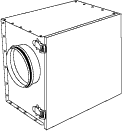
exhaust end showing 6” gasketed exhaust duct connector
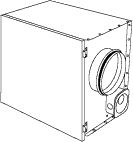
suction end showing 6” gasketed duct connector and electrical junction box
FAN PERFORMANCE
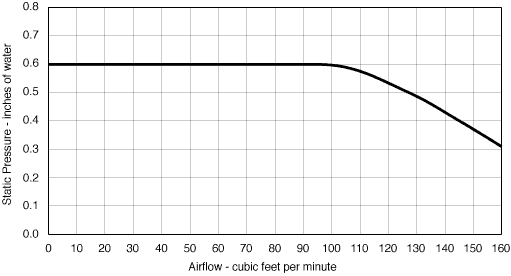
OCCUPANT-SENSING EXHAUST GRILLES: We stock five different exhaust grilles, each of which draws 8 cfm when closed and 50 cfm when fully opened:
Humidity-Sensing Grilles open and close continuously in response to varying humidity which makes them ideal for lightly-used bathrooms, laundry rooms, and kitchens (does not replace range hood fan). No electricity is needed to operate these grilles.
Motion-Sensing Grilles contain a passive infrared motion detector that causes the grilles to fully open for 25 minutes after the last movement in the room. This feature makes them ideal for powder rooms, toilet stalls, and other spaces where humidity levels are relatively constant. These grilles require a 9v internal battery or a wired 10-12vac power system plus an internal adapter card.
Humidity and Motion-Sensing Grilles combine the features of humidity and motion sensing grilles into one unit. This makes them ideal for actively used bathrooms, for example where there is a need to respond to humidity from morning showers and motion from toilet and sink use the remainder of the day.These grilles require a 9v internal battery or a wired 10-12vac power system plus an internal adapter card.
Switched Grilles are operated by a wall-mounted, momentary-contact, push-button switch (not included) that causes the grilles to fully open for 25 minutes. This feature makes them ideal for utility rooms and other spaces where ventilation is not routinely needed. These grilles require a 9v internal battery or a wired 10-12vac power system plus an internal adapter card.
Switched Humidity-Sensing Grilles combine the features of humidity-sensing and switched grilles into one unit. This makes them ideal for kitchens where the humidity-sensing feature maintains good background ventilation and the switch can be depressed to eliminate strong odors. They can also substitute for Humidity and Motion-Sensing Grilles for actively used bathrooms. These grilles require a 9v internal battery or a wired 10-12vac power system plus an internal adapter card.
All grilles measure 6” x 6” x 1.5” and are designed to press into 100 mm duct: wrapping several layers of electrical tape the inside of a short section of 4” pipe will yield a good fit.
Humidity-Sensing Grille |
Motion-Sensing Grille |
HUMIDITY-SENSING GRILLE PERFORMANCE
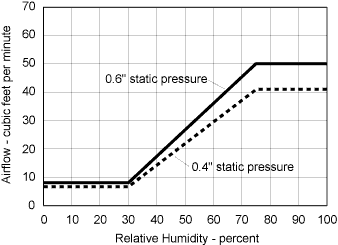
MOTION-SENSING OR SWITCHED GRILLE PERFORMANCE

FRESH-AIR GRILLES: Fresh-air grilles are installed in bedrooms and living spaces to allow the controlled entry of outdoor air to replace the interior air exhausted by the fan. They are only required in airtight buildings, since normal construction is sufficiently leaky to supply the air flow requirements of the exhaust grilles. Each grilles allows the entry of 3cfm to 24 cfm depending on the indoor humidity in the room: the grilles are so sensitive that the ventilation rate increases when a room is occupied. A mechanical switch is provided to shut off the airflow during very cold periods to prevent excess heat loss. A sound-absorbing liner and insect screen is included. The interior grille measures 5.5” x 9.5” x 2” and the exterior hood measures 6” x 6” x 1.5”. A 100mm pipe is provided to penetrate the wall. No electric power is required.)
Fresh-Air Grille |
Exterior Hood |
Through-Wall Pipe |
FRESH-AIR GRILLE PERFORMANCE
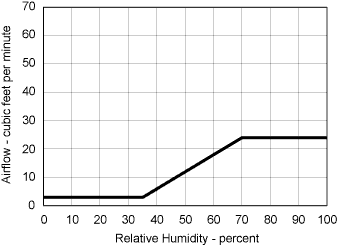
PRICING: Call or email for current pricing.




